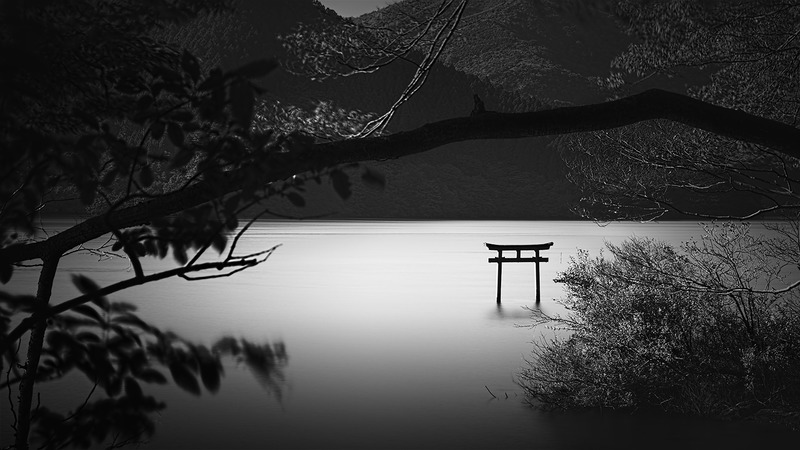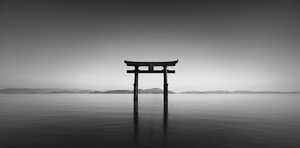Spiritual Landscape
"Floating Sanctuary --Water scape with Torii gate"
Since ancient times, torii shrine gates in Japan have symbolized the boundary marking the threshold of sacred ground. It is believed that the practice of torii construction based on bird worship dates back to the Yayoi period (around the 5th century BCE).
People revered the natural realm that lay beyond the reaches of human power as holy, regarding mountains, seas, waterfalls, islands, and ponds as objects of worship, and erecting torii to protect them. In some instances, they deemed these sacred places “forbidden lands” to protect the land itself or the vegetation growing on it; at the same time, they prayed that the spirits inhabiting the natural world would guard them in their daily lives. Whenever I glimpse one of these torii within the natural landscape, my spirit feels for an instant like it has been purified, and an unstoppable feeling of devoutness washes over me. The next moment, I sense this divine presence evaporating and rising into the sky.
In the case of torii built in water, they are often constructed on top of small islands in a sea or lake or off the tip of a cape, on protruding rocks, or amid other landscape elements that draw the eye. Our ancestors who lived on the Japanese archipelago, surrounded by seas, must have sensed divinity in the slightly extraordinary elements of an otherwise ordinary landscape. They built torii in these places, and in doing so began a prayer that has continued across generations, for safe oceangoing journeys and fishing expeditions, for abundant harvests of the sea’s bounty. Torii are not only the gates we pass through when visiting a shrine; those that stand within the natural landscape function as symbols of awe and piety toward nature’s power that have shaped the spirit of the Japanese people throughout history.
There are times when nature unleashes its power in the form of natural disasters, causing great harm and evoking our fearful awe, but nature also supports our livelihoods and daily lives. The Japanese language provides over a thousand ways to express the concept of “rain,” and as many for “wind”; the fact that these words are scattered as a matter of course throughout Japan’s ancient texts is evidence of the inseparable link that the Japanese people sense between nature and religious belief. Language, faith, and prayer, in other words, are for us intimately connected to natural phenomena, climate, geology, and topography.
The reason I feel both piety and spiritual calm when I see a torii rising from the water is, I believe, because this is an elemental landscape for the Japanese, a symbol of stopping in the midst of our busy lives, and looking and offering up a prayer to nature. It is the real landscape that is the foundation for the imagined landscapes we see in our mind’s eye. I believe this is perhaps the prehistoric source of the Japanese concept of spirituality that we call the Eight Million Gods—the belief, appearing even now in modern films such as those by Studio Ghibli, that divinity can be found even in a mote of dust.
When I visit these special landscapes to capture them with my camera, and find them littered with plastic bottles, bags, or empty cans, or I find the ocean poisoned with chemicals, the devastation of the surrounding environment appalls me. It is evidence that modern people have lost the ability to see the divine within landscapes and act with care, and that we Japanese are in the midst of losing our spiritual grounding. The purpose of religion is not to make us to bring our hands together and utter certain words; it is to shape our moral attitude and ethical perspective on life. It can perhaps even be said that these changes lie at the root of each and every environmental crisis.
On a final note, the characters for “torii” in Japanese can also be read literally as “presence of birds” or “place for birds”. Interestingly enough, while I was shooting, birds would often come to rest their wings on the torii gates, and I have included some photographs of them in these images.
It is my hope that the images in this project will allow us to glimpse together how our ancestors sought religion and spirituality within the natural landscape, and help us to pass those values on to future generations.
- Eriko Kaniwa
-> Gallery

Copyright (c) 2008-2025 by SENSEGRAPHIA- Eriko Kaniwa. All rights reserved.
All Images on this site are fully copyrighted, may not be used without written permission. Please contact me for any inquiries regarding use of images.







